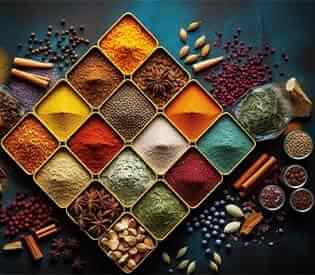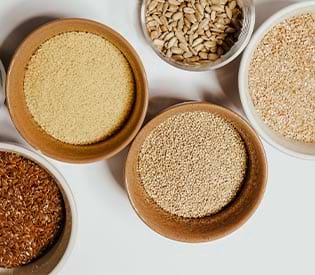Dried Safflower
📦🚚 Fast & Free shipping on all orders
What is dried safflower?
Within the daisy family, safflower is a thistle-like plant with rounded yellow or reddish-orange flower heads and rosettes. Bright yellows and reds were produced as a versatile dye before the plant was utilized for its health advantages in cooking, as a tea, or as an oil. People sometimes refer to safflower as "false saffron" due to its moderate and agreeable flavor, and they use it as a substitute for saffron in cooking. Traditional Chinese and Native American herbal medicine practitioners have long recognized the advantages of sunflower tea, which is believed to assist with respiratory, digestive, and certain cardiovascular illnesses. The herb's anti-inflammatory and antioxidant properties stem from a range of flavonoids. Additionally, safflower is high in fatty acids, calcium, magnesium, folate, and phosphorus.
How do I use dried safflower?
To begin, heat potable water to a boil. Subsequently, infuse one teaspoon of dehydrated safflower petals in a cup of heated water for an estimated duration of five minutes. Proceed to strain and serve. Although you can enjoy this tea without additional condiments, adding a teaspoon or so of honey enhances its flavor.
Dried safflower benefits:
Safflower includes compounds that may dilate blood vessels, reduce blood pressure, stimulate the heart, and prevent blood clots. Safflower oil is used to treat a wide range of illnesses, including diabetes, heart disease, stroke, high cholesterol, and diabetes, although the majority of these applications lack strong scientific backing.
◉ Skin Health: Safflower oil is an emollient that softens, lubricates, and helps to retain moisture in the skin when applied topically. Cold-pressed safflower seed oil is full of fatty acids, especially linolenic acid, which the body needs to make ceramides. Ceramides are important parts of the epidermal layer that help the barrier function and keep skin moist. One essential part of the skin barrier, ceramide 1 linoleate, is made from linolenic acid. According to studies, linoleate levels drastically decrease with age and throughout the winter, resulting in dry, flaky skin. Linolenic acid-containing oils, such as safflower, aid in maintaining the skin's moisture content by restoring barrier function, which in turn helps to replace linoleate levels.
◉ Hair Care: Safflower oil protects hair follicles from damage caused by free radicals while also nourishing and penetrating them. Additionally, rubbing safflower oil into the scalp promotes circulation, which fortifies hair follicles and promotes strong, healthy hair growth. It is also high in oleic acid, a powerful stimulant for the scalp. It also relieves a dry, itchy scalp and gets rid of dandruff. Safflower oil is simple to absorb by the hair, entering each hair shaft and delicately piercing the cuticle to provide a powerful boost of nourishment and moisture precisely where it is most needed. Additionally, it keeps hair from losing protein, resulting in longer, thicker hair.
The ceramides described earlier are also crucial for healthy hair; they function as the glue holding your hair together. Safflower oil is excellent for helping hair recover from the aftereffects of chemical hair colors because it stimulates the formation of ceramides, which in turn promotes strong, silky hair. You can apply it to clean, combed hair and use your fingers to massage it into the scalp as a conditioner. To help spread the oil from the tips to the roots in a uniform layer, use a comb. You may let this conditioner sit in your hair for 45 to 60 minutes, then use a natural shampoo to completely remove it. Hair that has undergone this process at least once a week will feel nourished, lustrous, silky, and healthy.
◉ Improves blood sugar levels: According to a comprehensive analysis of research published in 2016, consuming a diet rich in unsaturated fats may help people better regulate their blood sugar levels. The research discovered that blood sugar levels, insulin resistance, and insulin secretion were all improved when specific sources of saturated fats or carbohydrates were swapped out for unsaturated fatty acids, particularly polyunsaturated fats.
According to 2011 research, certain type 2 diabetics may have improvements in blood sugar and less inflammation after taking 8 grams (g) of safflower oil every day for four months. Importantly, the women who participated in this research were postmenopausal and had type 2 diabetes in addition to obesity. The scientists propose that, in addition to diabetic medications, individuals should take high-quality dietary fats to lessen the condition's negative effects.
◉ Fights inflammation: Research published in Clinical Nutrition found that safflower oil and its unsaturated fatty acids reduced inflammatory indicators. Diabetes and heart disease are two ailments that such oils may assist with.
Where can I buy dried safflower?
Buy dried safflower from the health food store in the USA, Alive Herbals.
Dried safflower information (at a glance):
| Product Name | Dried Safflower. |
| Scientific Name | Carthamus tinctorius L. |
| Country of Origin | It is native to Central Asia. |
| Ingredient | Dried Safflower. |
| Taste & Aroma | A sweet, somewhat smoky, chocolatey scent combined with a taste that is mildly flowery. |
| Shelf Life & Storage | Shelf life is about 6–12 months. Store it in an airtight container in a cool, dry place and prevent sunlight exposure. |
| Precautions | We requested you, Before consuming spices, herbs, teas or any kind of natural products you consult an expert qualified healthcare practitioner or herbalist. |
| Note | This product information has not been appraised by the Food and Drug Administration (FDA). This information is solely intended for educational purposes. |







